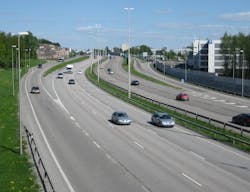European project seeks to use the cloud to spot road hazards
This pilot project, expected to start in 2016, intends to assess the capability of current and emerging mobile network and location cloud technologies to transmit critical road safety information in real-time to vehicles, such as black ice, an animal on the highway, sudden traffic build-up, or an accident.
George Filley, who heads HERE’s digital transportation infrastructure program, said in a statement that his company is being tasked by the Finnish Transport Agency (FTA) and Trafi, the Finnish Transport Safety Agency, to lead this pilot – called Coop – and will work together with traffic information management service company Infotripla in implementing it.
[Sounds pretty neat, but let’s not forget some of the security concerns that go along with the brave new world of cloud computing.]
He said that this pilot project will be the first to implement a road hazard warning messaging system as described in the Intelligent Transportation Systems (ITS) directive set out by the European Union – a project, interestingly enough, that does not require the deployment of any additional roadside infrastructure, such as DSRC or “dedicated short range communications” equipment, although Filley stressed that HERE is pursuing an “agnostic approach” with its technologies that will allow for connections with other infrastructure if required.“With this project, we will explore how technology within our reach today could make driving safer as cars get connected,” he explained. “There will be enormous amounts of data generated by a car’s on-board sensors that can be collected, analyzed and shared with others on the road. An important piece of the puzzle is to figure out how to provide relevant, low-latency information to the right people at the right time, and that is a problem we believe we can solve.”
Filley said HERE’s pilot project is aimed at testing the capability of the proposed technology architecture, with drivers voluntarily sharing notifications about safety hazards and changing road conditions initially via a smartphone.
The aim, however, is that this architecture would later also support low-latency communication, via a cloud, of data generated by a vehicle’s on-board sensors and the surrounding road infrastructure to other vehicles and smart devices on the road, he noted.According to a recent forecast from automotive technology research firm SBD, by 2020 there will be some 33 million vehicles sold annually with built-in connectivity, generating more than 163 million terabytes of data each year via their on-board cameras and sensors.
When shared across the road network using 4G/LTE and future 5G network technologies, that data could be utilized by vehicles to give them an awareness of road conditions beyond the reach of their sensors, and thus enable the driver or the vehicle itself to better plan driving maneuvers, noted Alain Dunoyer, head of SBD’s safe car division.
“The technology exists to identify road hazards with increasing levels of accuracy,” he said. “5G technology raises the prospect of road hazard warnings being communicated via the cloud to relevant vehicles in a fraction of a second.”
So here’s how this HERE-led project is expected to roll:
- The first phase of the pilot will focus on ensuring the technical maturity of the system.
- The second phase begins in the first half of 2016 on the E18 highway, the main road between Helsinki and Turku, as well as the Ring I and Ring III highways in the Greater Helsinki area, with initially up to 1,000 drivers expected to take part.
- The pilot phase is expected to complete by the end of 2017.
The company also published last week a new “interface specification” that defines how sensor data gathered by vehicles on the road can be ingested by a cloud-based computer system.
Filley said HERE intends for this “interface specification” to become a standardized way for vehicles to send to the cloud the wide variety of data gathered by on-board sensors. [You can read more about this in the HERE 360 blog.]
“With a standard interface specification, the data generated would be analogous regardless of vehicle manufacturer and could be pooled, processed and analyzed quickly to create an enhanced view of road and traffic conditions,” noted Filley.
Let’s see if this all develops as expected.



